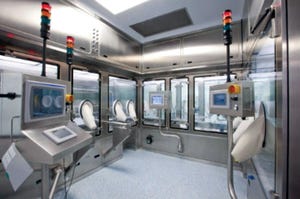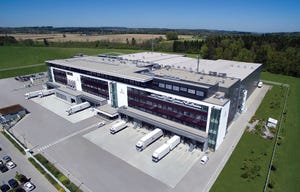April 2018 Featured Report
Cook Pharmica’s flexible filling line in Bloomington, IN, won the 2017 ISPE Facility-of-the-Year award for equipment innovation. (WWW.BUSINESSWIRE.COM)
Today’s biomanufacturers need to be able to add capacity and capability quickly; provide increased supply service to customers on demand; and streamline the flows of personnel, traffic, utilities, and materials throughout bioprocess facilities. And companies need to be flexible enough to subtract capacity and retool quickly to produce new or different products. Many future facilities will be automated to some extent and use robotics in manufacturing. With personalized medicine on the rise, bioprocessors can benefit from colocation with academic research centers, laboratories, and clinics. Working in partnership, they could improve process development, scale-up, and adaptable clinical and commercial-scale manufacturing. Future facilities should be designed to affect the environment as minimally as possible. And they would do well to be built with employees’...
The title of this featured report —
Smart(er) Facilities
— came about in conversations with our KNect365 colleagues as they worked to plan this year’s BPI West conference, which took place 19–22 March 2018 in San Francisco, CA. For decades, biopharmaceutical facilities have incorporated cutting-edge designs for supporting processes, products, and human development. Each year, design innovations are rewarded for creating workspaces that facilitate both worker comfort and essential movement of promising drug candidates toward commercialization. In that context, biomanufacturing facilities around the world are getting smarter than ever before — applying a number of related definitions to the term smart — but that does not mean that one size fits all. In fact, a central theme behind most presentations at BPI West was that the more knowledge a company has about its products and processes, the smarter the decisions it can make about designing workspaces that capitalize on essential similarities, shared resour...
Facility of the Future_Ravensburg Vetter West RVW
Biomanufacturers are constantly tasked with making their products ever more efficiently with ever increasing quality. As major advancements come in biomanufacturing technology, companies find themselves in need of “smarter,” more flexible facilities than ever before. Recently, I asked several industry leaders for their thoughts on some criteria for smarter designs, including why there is such a demand:
Flexibility
BPI:
What industry trends feed into the need for flexibility? We think of single-use technology and modular facilities as means to that end, but what are some other aspects?
Whitford:
One trend feeding that need for “flexibility” from modular and single-use facilities involves a desire to produce more than one type of molecular entity within the same facility or suite. That capability could support unplanned changes in the products being supported, such as from approval failure or postapproval market forces, scheduled changeover to a different ...








